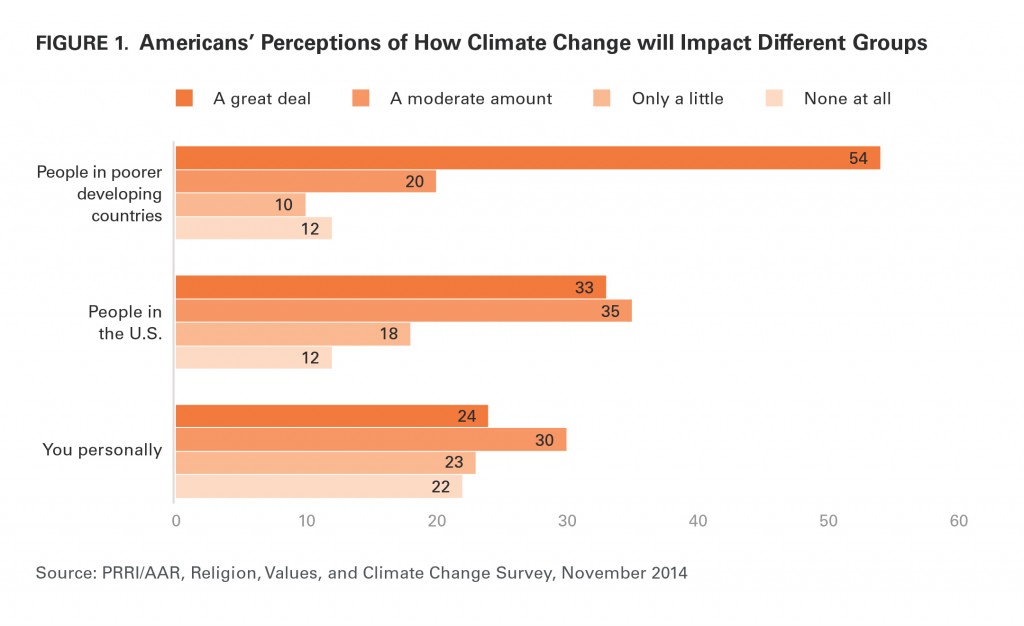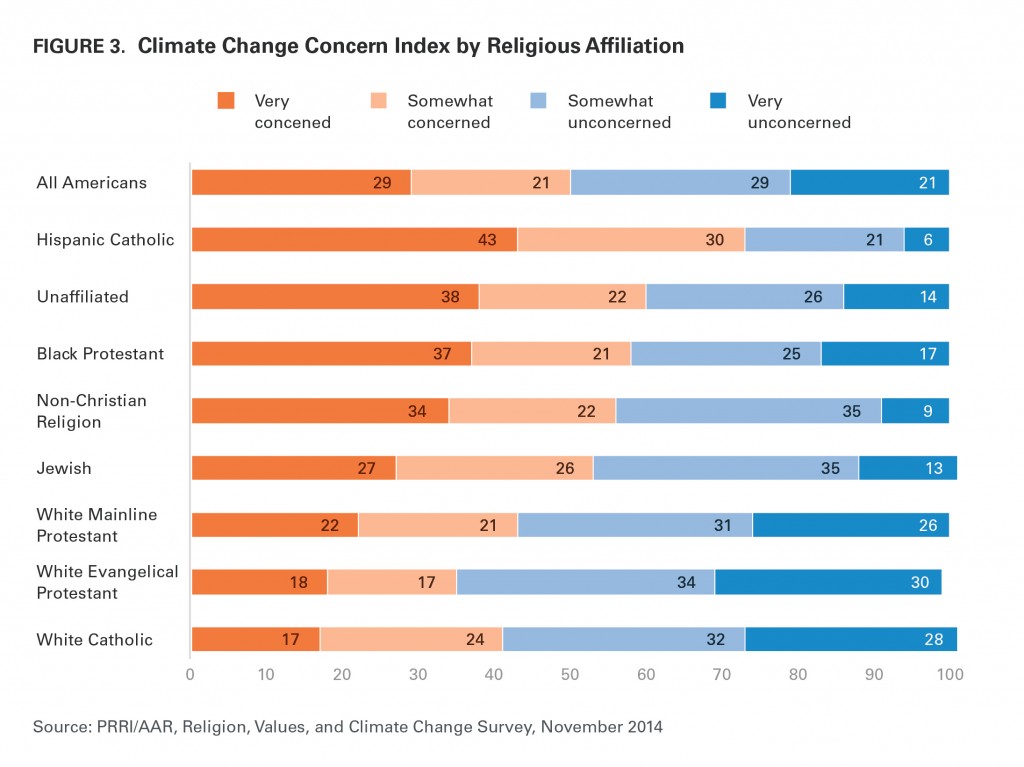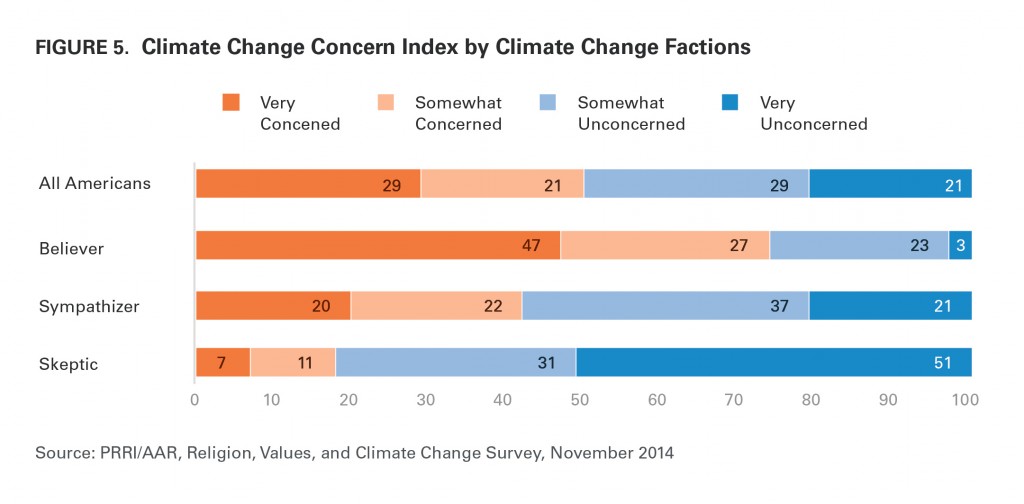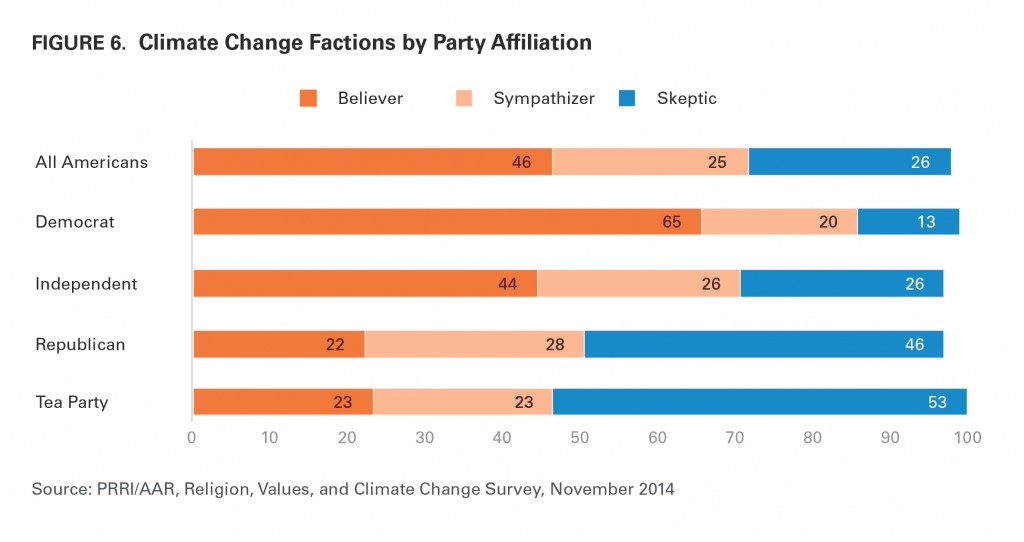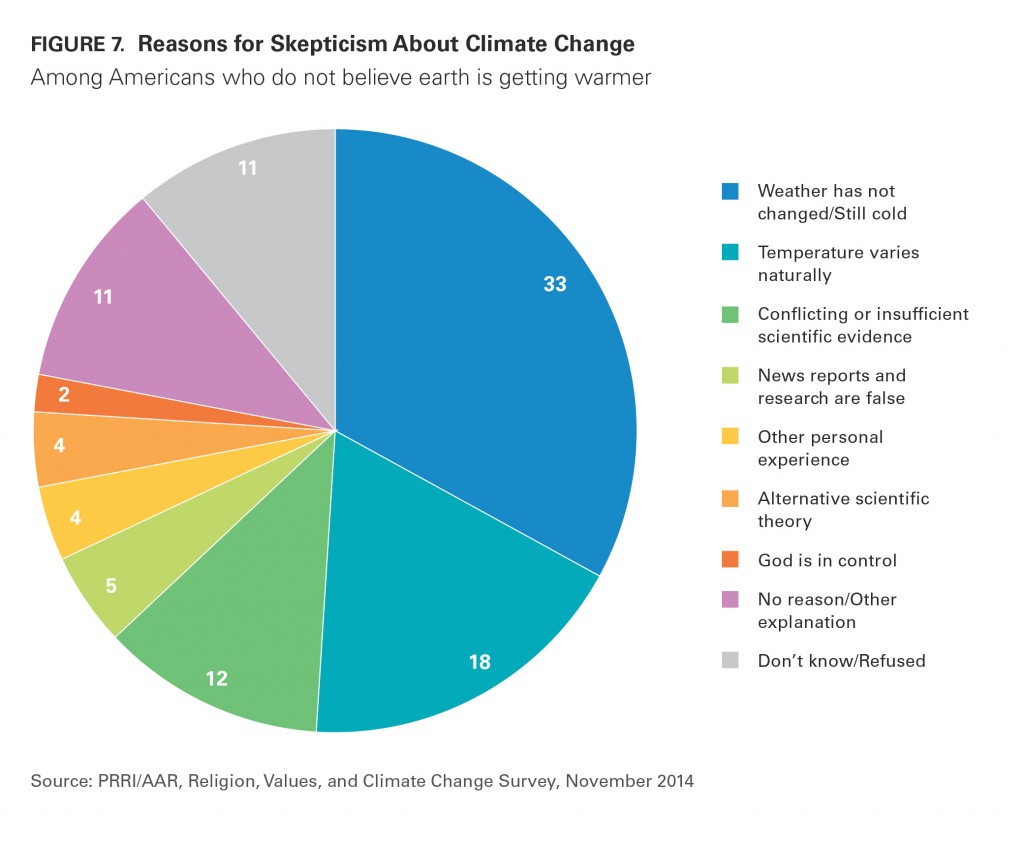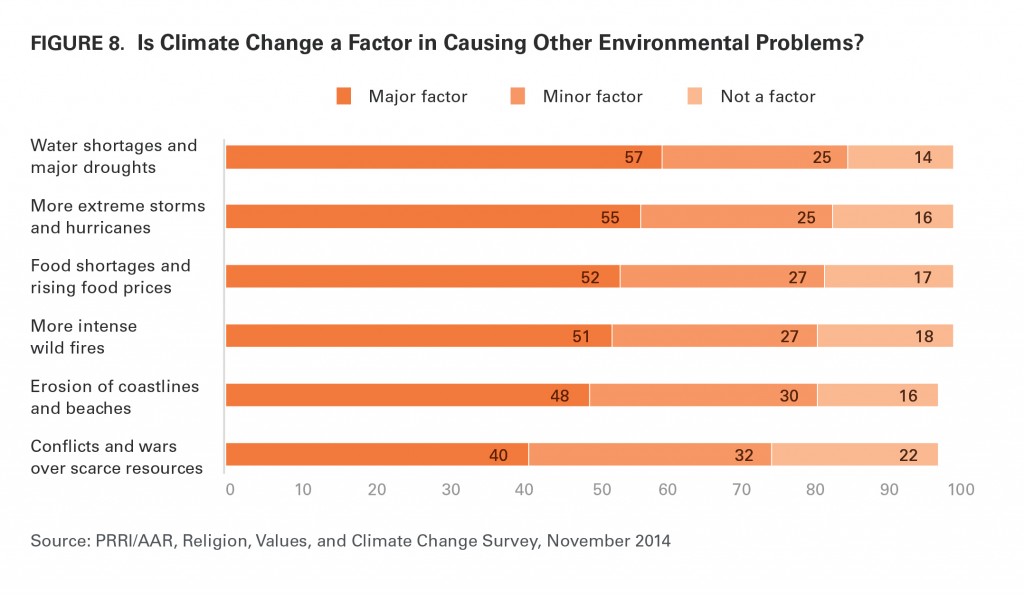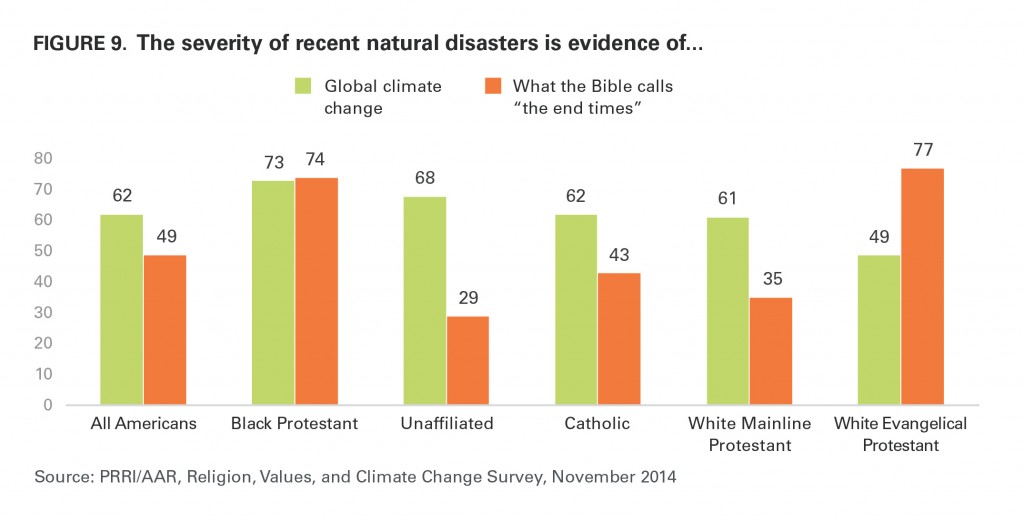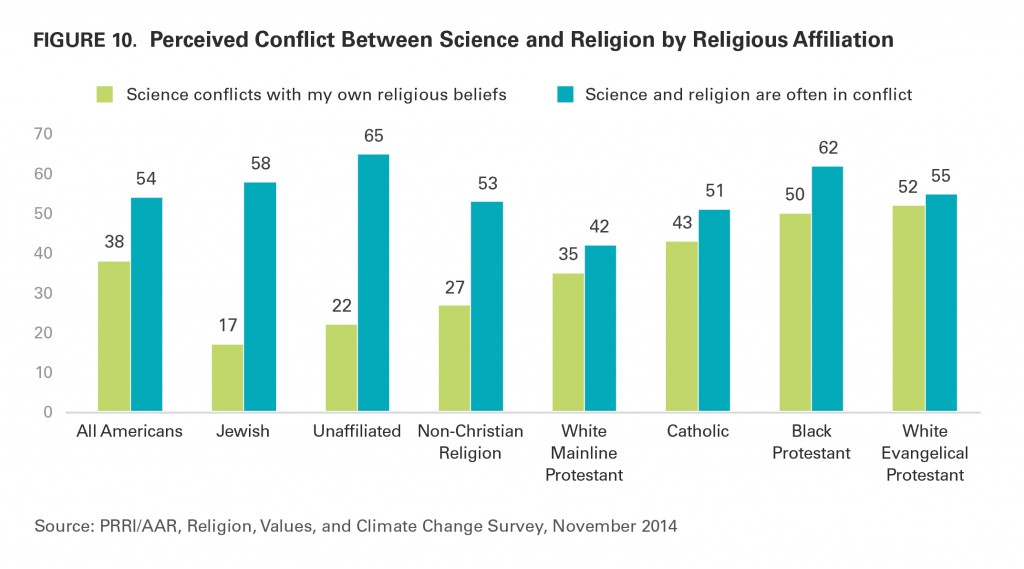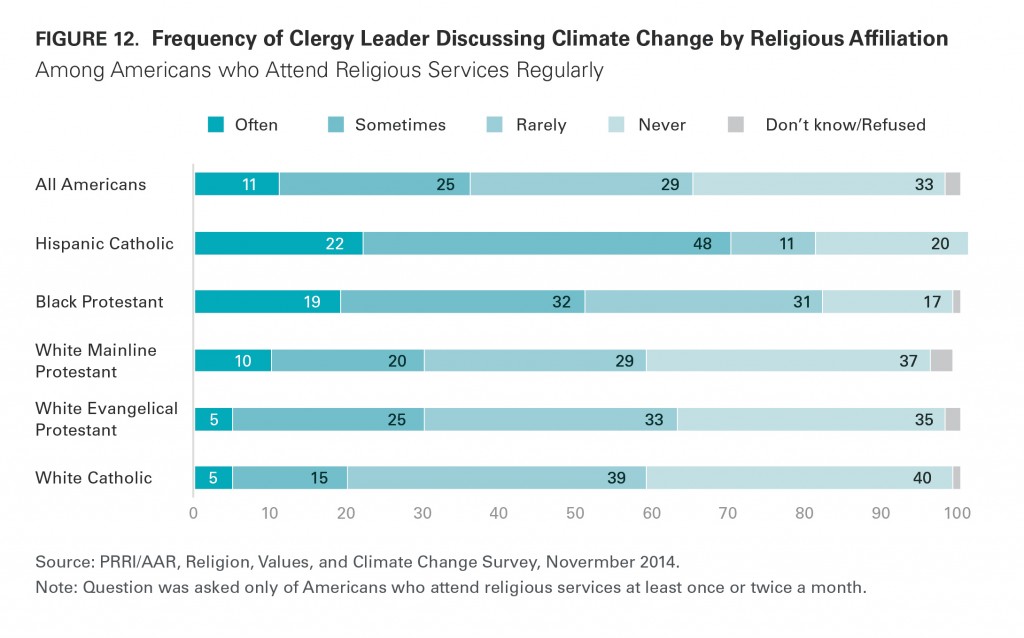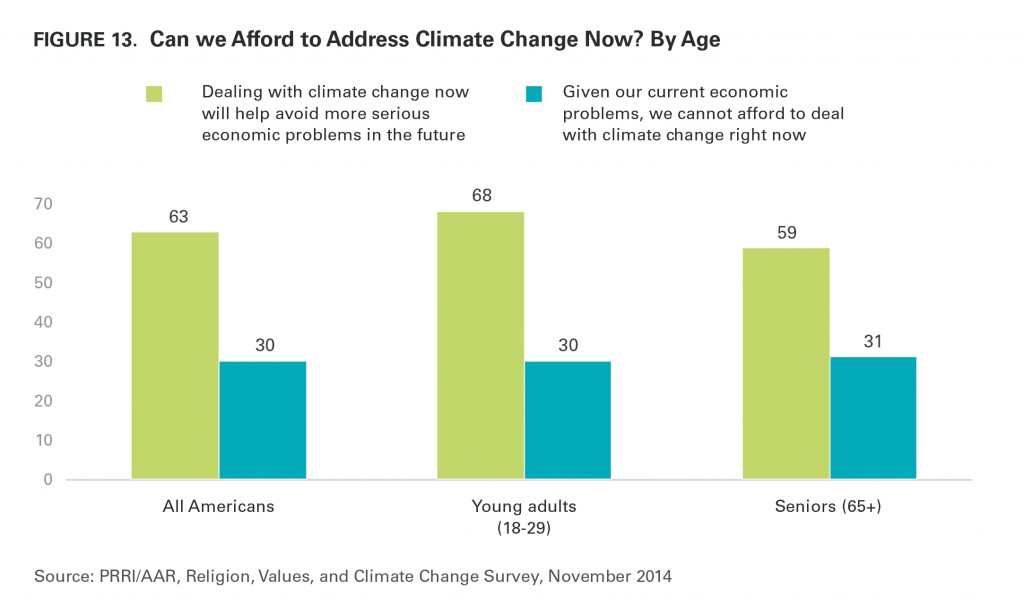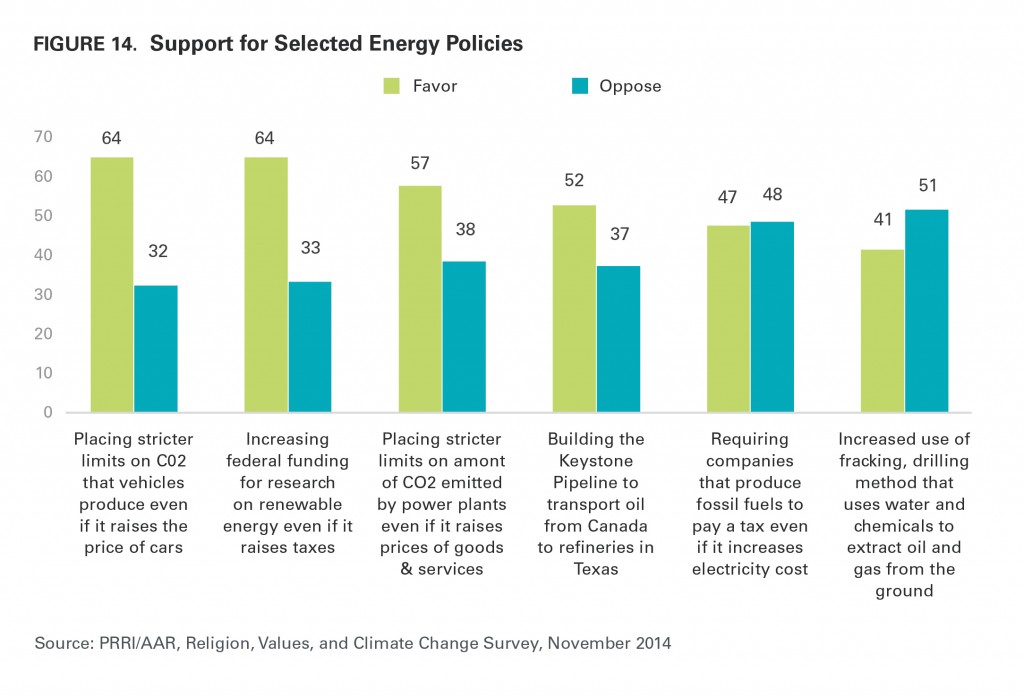Executive Summary
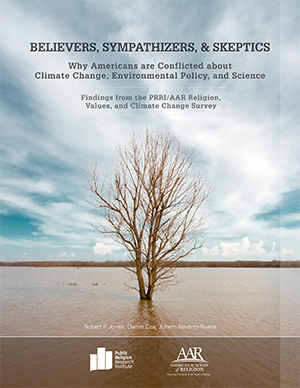 The Importance of and Concerns about Climate Change
The Importance of and Concerns about Climate Change
Americans rank climate change last on a list of important issues. Only five percent of Americans say climate change is the most important issue facing the U.S. today. The issue of climate change ranks behind the lack of jobs (22%), the increasing gap between rich and poor (18%), health care (17%), the budget deficit (13%), immigration reform (10%), and the rising cost of education (9%).
When asked which environmental problem is most important for the current administration to tackle, nearly 3-in-10 (29%) Americans point to air, water, and soil pollution. One-quarter (25%) of Americans say climate change is the most pressing environment problem, while a similar number (23%) identify water shortages and drought. Fewer Americans cite the shrinking of wilderness areas and animal habitats (11%) or endangered species (4%) as the most critical environmental issue.
Americans are significantly more likely to believe that people living in poorer developing countries will be harmed by climate change than they are to say that they personally, or U.S. residents as a whole, will be negatively affected by climate change.
Less than one-quarter (24%) of Americans believe that they will be personally harmed a great deal by climate change, while 30% say climate change will affect them a moderate amount. More than 4-in-10 Americans say climate change will have only a little (23%) or no impact (22%) on them personally.
One-third (33%) of Americans say the U.S. public overall will experience a great deal of harm due to climate change, while 35% say the U.S. public will experience a moderate amount of harm. Three-in-ten Americans say that climate change will impact people living in the U.S. only a little (18%) or not at all (12%).
A majority (54%) of Americans say that people living in poorer developing countries will be harmed a great deal as a result of climate change, while 20% say they will experience a moderate amount of harm. Less than one-quarter of Americans believe that people living in developing countries will be affected only a little (10%) or not at all (12%) as a result of climate change.
About one-quarter (23%) of Americans say that climate change is a crisis and 36% say it is a major problem, while nearly 4-in-10 Americans say climate change is a minor problem (23%) or not a problem at all (16%).
The Climate Change Concern Index—a composite measure that combines perceptions about whether climate change is a crisis and whether it will have adverse personal effects—finds that nearly 3-in-10 (29%) Americans are very concerned about climate change, 21% are somewhat concerned, 29% are somewhat unconcerned, and 21% are very unconcerned.
More than 7-in-10 Hispanic Americans are very (46%) or somewhat (25%) concerned about the impact of climate change. Similarly, nearly 6-in-10 black Americans are very (36%) or somewhat (21%) concerned about climate change. By contrast, less than half of white Americans are very (23%) or somewhat (20%) concerned about climate change.
Two-thirds of Democrats are very or somewhat concerned about climate change (41% and 26%, respectively), compared to fewer than 3-in-10 Republicans (14% and 15%, respectively). Independents are nearly evenly divided.
More than 6-in-10 (63%) Americans agree that dealing with climate change now will help avoid more serious economic problems in the future, while 3-in-10 (30%) say that given our current economic problems, we cannot afford to deal with climate change right now.
The generational differences on this question are modest. Nearly 7-in-10 (68%) young adults (age 18-29) say we should deal with climate change now, compared to 59% of seniors (age 65 and older).
Americans’ perspectives on whether the global temperature is rising have remained stable over the past few years. Nearly 7-in-10 (69%) Americans believe there is solid evidence that the earth’s average temperature has been increasing over the past few decades, while approximately one-quarter of Americans (26%) say they do not believe the earth is getting warmer. In 2011, an identical number of Americans (69%) said they believed that the earth’s average temperature was rising.
To better understand the range of belief in climate change, PRRI identified three groups of Americans, divided by their opinions about the existence and causes of climate change.
Close to half (46%) of Americans say that the earth is getting warmer and that these changes are primarily the result of human activity. We characterize this group as climate change “Believers.”
One-quarter (25%) of Americans believe the global temperature is rising, but say the change is due to natural fluctuations in the earth’s environment or are uncertain about its cause. We describe this group as climate change “Sympathizers.”
Finally, more than one-quarter (26%) of Americans say there is no solid evidence that the earth’s temperature has been rising over the past few decades. We call this group climate change “Skeptics.”
Skeptics were asked to share, in their words, why they believe the earth’s temperature is not increasing. Answers varied considerably, but the most frequently cited reason (33% of all open-ended answers) was that they have not noticed a change in the weather around them.
Climate change Believers are substantially more likely to than Sympathizers or Skeptics to score high on the Climate Change Concern Index.
Nearly three-quarters of Believers are very (47%) or somewhat (27%) concerned about climate change.
About 4-in-10 Sympathizers are very (20%) or somewhat (22%) concerned about climate change.
Less than 1-in-5 Skeptics are very (7%) concerned or somewhat (11%) concerned about climate change, while more than 8-in-10 say they are somewhat (31%) or very (51%) unconcerned.
Democrats have a higher percentage of climate change Believers within their ranks, while Republicans and Americans who identify with the Tea Party are more likely to be climate change Skeptics.
Nearly two-thirds (65%) of Democrats are climate change Believers, 20% are Sympathizers, and 13% are Skeptics.
Less than 1-in-4 (22%) Republicans are climate change Believers, 28% are Sympathizers, and nearly half (46%) are Skeptics.
Americans who identify with the Tea Party are even more skeptical about the existence of climate change than Republicans. Less than one-quarter (23%) of Tea Party members are climate change Believers, 23% are Sympathizers, and a majority (53%) are Skeptics.
White evangelical Protestants are more likely than any other religious group to be climate change Skeptics. Only 27% of white evangelical Protestants are climate change Believers, while 29% are Sympathizers and nearly 4-in-10 (39%) are Skeptics.
To better understand how Americans’ spirituality intersects with their attitudes toward the environment, PRRI created a Spiritual Experiences Index by combining four spiritual experience measures.
The Spiritual Experiences Index finds that about 4-in-10 Americans report very high (19%) or high (21%) frequency of spiritual experiences. One-quarter (25%) of Americans report moderate frequency of spiritual experiences, and approximately one-third of Americans report low (16%) or very low (19%) frequency of spiritual experiences.
Americans who report higher frequency of spiritual experiences are generally more likely to score high on the Climate Change Concern Index. A majority of Americans who report spiritual experiences very frequently are very (35%) or somewhat (20%) concerned about climate change. In contrast, less than half of Americans who report very infrequent spiritual experiences are very (21%) or somewhat (20%) concerned about climate change.
However, there is no significant relationship between frequency of spiritual experiences and beliefs about the reality and causes of climate change.
Most Americans who attend religious services at least once or twice a month hear little from their clergy leader about the issue of climate change. Just over one-third of Americans say their clergy leader speaks about climate change often (11%) or sometimes (25%). More than 6-in-10 Americans say their clergy leader rarely (29%) or never (33%) references climate change.
Americans who say their clergy leader speaks at least occasionally about climate change are more likely to be climate change Believers than Americans who tend not to hear about climate change in church (49% and 36%, respectively).
Americans who say their clergy leader speaks at least occasionally about climate change also score higher on the Climate Change Concern Index. More than 6-in-10 Americans who report hearing about climate change from their clergy leader at least occasionally are very (38%) or somewhat (24%) concerned about climate change, compared to approximately 4-in-10 (39%) Americans who attend congregations where the issue is rarely or never raised.
Although a majority (54%) of Americans believe that science and religion are often in conflict, substantially fewer say that science clashes with their own religious beliefs. Nearly 6-in-10 (59%) Americans say that science does not conflict with their religious beliefs, while roughly 4-in-10 (38%) disagree saying that science sometimes conflicts with their religious beliefs. These attitudes have remained stable over the last few years.
When asked about these causes separately, Americans are more likely to say that recent natural disasters are the result of climate change (62%) than biblical “end times” (49%).
The number of Americans who believe natural disasters are evidence of the apocalypse has increased since 2011, when only 44% agreed.
White evangelical Protestants are much more likely to attribute the severity of recent natural disasters to the biblical “end times” (77%) than to climate change (49%).
Most Americans do not believe that God would intercede to prevent humans from destroying the earth. Approximately 4-in-10 (39%) Americans believe that God would not allow humans to destroy the earth, while a majority (53%) of Americans disagree.
Americans generally reject the idea that God intended humans to use the earth strictly for their own benefit. Nearly 6-in-10 (57%) Americans say God gave humans the task of living responsibly with animals, plants, and other resources, which are not just for human benefit. By contrast, about one-third (35%) of Americans believe that God gave human beings the right to use animals, plants, and all other resources of the planet solely for their own benefit.
More than 6-in-10 (64%) Americans who believe that the global temperature is increasing say that major sacrifices will have to be made in order to solve the climate change problem, while roughly 3-in-10 (28%) say that technology will be able to solve the problem of climate change without requiring substantial sacrifices.
Regardless of whether Americans believe the primary solution to climate change will come from the private or public sector, nearly 7-in-10 (69%) Americans believe that the U.S. government needs to do more to address the issue of climate change, while nearly 3-in-10 (29%) Americans disagree. Support for increased government action on climate change has remained stable over the past two years.
Americans are broadly supportive of energy policies that place additional limits on carbon dioxide emissions, even if these policies impose new costs.
Nearly two-thirds (64%) of Americans support placing stricter limits on vehicle emissions even if it results in higher car prices for consumers, while roughly one-third (32%) of Americans are opposed.
Nearly 6-in-10 (57%) Americans favor stricter limits on the amount of carbon dioxide emitted from power plants even if they raise the price of goods and services, while 38% of Americans are opposed.
Americans are more divided over policies related to the production of traditional fossil fuels.
A majority (52%) of Americans support the building of the Keystone XL pipeline, which would transport oil from Canada’s oil sands region through the Midwest to refineries in Texas. Nearly 4-in-10 (37%) Americans are opposed to the building of the pipeline.
A slim majority (51%) of Americans oppose the increased use of “fracking,” a drilling method that uses high-pressure water and chemicals to extract oil and natural gas from underground rock formations. Approximately 4-in-10 (41%) Americans favor the increased use of “fracking.”
Americans are nearly evenly divided in their support for a policy that would impose an additional tax on companies that produce fossil fuels, even if the policy results in higher electricity costs: 47% are in favor, while 48% are opposed.
However, a majority of Americans support funding for research on alternatives to fossil fuels. Nearly two-thirds (64%) of Americans favor increasing federal funding for research on renewable energy sources such as wind, solar, and hydrogen, even if it raises taxes. One-third (33%) of Americans oppose such a change.
I. Americans’ Interest in News and Science
Interest in News and Current Events
Nearly half (45%) of Americans say they enjoy keeping up with the news a lot, while about one-third (31%) say they enjoy it somewhat. Roughly one-quarter of Americans say they do not enjoy following the news much (16%) or at all (8%).
Americans of different ages and educational backgrounds derive varying degrees of enjoyment from news and current events. Seniors (age 65 and older) are substantially more likely than young adults (age 18 to 29) to report that they enjoy keeping up with the news a lot (63% and 24%, respectively). Similarly, more than 6-in-10 (61%) Americans with a post-graduate education say they enjoy following the news, compared to roughly one-third (35%) of Americans with a high school education or less.
Political independents are also less likely than Americans who identify with a political party or movement to say they enjoy following current events. Nearly 6-in-10 (58%) Americans who identify with the Tea Party and roughly half of Republicans (52%) and Democrats (49%) say they enjoy following the news and current events a lot compared to fewer than 4-in-10 (39%) independents.
Interest in Scientific Developments
Americans are moderately interested in news about science compared to a variety of other topics. Three-in-ten (30%) Americans say their preferred news topic is politics and government, while 17% of Americans say they are most interested in international affairs and 14% of Americans say they are most interested in sports. About 1-in-10 (11%) Americans say they are most interested in news about science and technology. Fewer than 1-in-10 Americans say they are most interested in news about arts, entertainment and fashion (8%), business (6%), or religion (5%).
Nearly 7-in-10 Americans say they pay a lot of attention (25%) or some attention (43%) to news reports about developments in science, while about one-third of Americans say they pay little (21%) or no (11%) attention to coverage of scientific progress.
The degree to which Americans follow developments about science in the news varies by age, educational background, race, and gender. Seniors (31%) are nearly twice as likely as young adults (17%) to say they pay a lot of attention to news reports about developments in science. Americans with a post-graduate education (41%) are more than twice as likely as Americans with a high school education or less (18%) to say they pay a lot of attention to news reports about developments in science. Black Americans (31%) are more likely than white Americans (25%) or Hispanics (22%) to say they pay a lot of attention to news coverage of scientific progress. Nearly 3-in-10 (29%) men say they pay a lot of attention to news about developments in science compared to about 1-in-5 (21%) women.
White evangelical Protestants are less likely than members of other religious groups to say they follow news coverage about scientific developments. Fewer than 1-in-5 (17%) white evangelical Protestants say they pay a lot of attention to news reports about developments in science, compared to least one-quarter of all other major religious groups, including Jewish Americans (36%), black Protestants (30%), white mainline Protestants (27%), religiously unaffiliated Americans (26%), and Catholics (26%).
Sources of Information about Science and Technology
Today, Americans get most of their information about science and technology from the Internet or television programming. Close to half (44%) of Americans report that they get most of their information about science and technology from the Internet, while more than 3-in-10 (31%) say they receive this type of information mostly from television shows. Substantially fewer say they get most of their information about science and technology from newspapers (8%), friends and family members (7%), and magazines (6%).
Americans’ reliance on the Internet for information about science and technology is relatively new. The percentage of Americans who say the Internet is their primary source for information about science and technology has nearly doubled over the course of the past decade. In 2006, fewer than one-quarter (23%) of Americans reported that their main source for information about science and technology was the Internet, while nearly 4-in-10 (39%) said they received most of this information from television programs.(1)
Not surprisingly, younger Americans tend to rely heavily on the Internet for information about science and technology, while older generations still look to traditional media sources like television or newspapers. More than 7-in-10 (71%) young adults say they get most of their information about science and technology from the Internet, compared to 17% of seniors. Nearly half (46%) of seniors say television programs are their main source of information about science and technology compared to 14% of young adults. Seniors are also more likely than young adults to get information about science and technology from newspapers (18% and 2%, respectively) and magazines (10% and 2%, respectively).
There are also divisions by level of educational attainment. A majority (58%) of Americans with a post-graduate education say they get most of their information about science and technology from the Internet, while fewer than 1-in-5 (17%) look to television programs for information about science. In contrast, Americans with a high school education or less are about equally as likely to say they get most of their information about science and technology from the Internet (37%) as they are to say they get most of this information from television programs (41%).
Racial and ethnic groups also differ in their primary source of information about science and technology. Although similar numbers of white (45%), Hispanic (43%), and black (37%) Americans point to the Internet as their primary source for information about science and technology, Hispanics (41%) and black Americans (43%) are more likely than white Americans (28%) to say they get most of their information about science and technology from television shows.
II. The Importance of Climate Change
The Importance of Climate Change Relative to Other Issues
When asked to identify the most pressing issue facing the country, few Americans prioritize climate change over other social and economic issues. Only five percent of Americans say climate change is the most important issue facing the U.S. today. By contrast, nearly one-quarter (22%) of Americans say the lack of jobs is America’s most pressing problem. About 1-in-5 Americans cite the increasing gap between rich and poor (18%) or health care (17%) as the most serious issue facing the nation. About 1-in-10 Americans say the budget deficit (13%), immigration reform (10%), and the rising cost of education (9%), are the most important issues confronting the U.S.
Americans with different political and ideological leanings vary somewhat in their assessment of climate change’s urgency. Democrats (7%) and independents (6%) are more likely than Tea Party members (2%) and Republicans (1%) to say that climate change is the most important issue facing the U.S. today. Similarly, political liberals (10%) are more likely than moderates (5%) or conservatives (1%) to say that climate change is the most important challenge facing the country.
The Most Important Environmental Problem
When asked to identify which environmental problem the current administration should prioritize, nearly 3-in-10 (29%) Americans identify air, water, and soil pollution. One-quarter (25%) of Americans say climate change is the most pressing environment problem, while a similar number (23%) point to water shortages and drought. Roughly 1-in-10 (11%) Americans say the shrinking of wilderness areas and animal habitats is most important, while four percent of Americans want the current administration to focus on the problem of endangered species.
There are significant differences by race and ethnicity on environmental priorities. Nearly 4-in-10 (39%) black Americans say the current administration should focus on climate change, compared to 24% of white Americans and 21% of Hispanics. Hispanics (46%), in turn, are more likely than black (29%) and white (24%) Americans to say that pollution is the country’s most serious environmental problem. In their assessments of the most pressing environmental problem, white Americans are evenly divided between water shortages and drought (25%), pollution (24%), and climate change (24%).
Americans are also divided by political affiliation on the relative urgency of various environmental problems. Democrats (41%) are substantially more likely than any other political group—including independents (23%), Tea Party members (15%), and Republicans (10%)—to say that the current administration should prioritize climate change. By contrast, Republicans (32%) are more likely than independents (23%) and Democrats (18%) to say the current administration should focus on water shortages and drought.
White evangelical Protestants differ from other religious groups on the question of environmental priorities. Black Protestants (37%), religiously unaffiliated Americans (35%), Catholics (24%), and white mainline Protestants (23%) are more likely than white evangelical Protestants (11%) to say that climate change is the most pressing environmental issue. By contrast, one-third (33%) of white evangelical Protestants say the current administration should prioritize water shortages and drought compared to 23% of white mainline Protestants, 23% of Catholics, 18% of religiously unaffiliated Americans, and 16% of black Protestants.
Americans’ level of concern about particular environmental problems also varies according to gender, age, and educational attainment. Men (28%) are slightly more likely than women (23%) to identify climate change as the county’s most pressing environmental problem. Roughly one-third (32%) of women say air, water, and soil pollution is the most important environmental issue compared to one-quarter (25%) of men. Seniors (age 65 and older) are more likely than young adults (age 18-29) to say that water shortages and droughts (27% and 14%, respectively) and climate change (28% and 20%, respectively) should be the current administration’s environmental priority. Young adults, on the other hand, are more likely than seniors to rate air, water, and soil pollution as their top environmental concern (34% and 25%, respectively). Meanwhile, Americans with a post-graduate education (38%) are substantially more likely than Americans with a high school education or less (16%) to name climate change as the most important environmental problem.
Is Climate Change a Crisis?
A majority of Americans say that climate change is either a crisis (23%) or a major problem (36%). By contrast, nearly 4-in-10 Americans say climate change is a minor problem (23%) or not a problem at all (16%).
Members of various political groups have different perspectives on the urgency of climate change. More than three-quarters of Democrats describe climate change as a crisis (34%) or a major problem (43%). Approximately 6-in-10 independents also say climate change is a crisis (21%) or a major problem (40%). By contrast, roughly one-third of Republicans and Tea Party members say climate change is a crisis (12% and 13%, respectively) or a major problem (24% and 20%, respectively). Approximately 6-in-10 Republicans and nearly two-thirds of Tea Party members say that climate change is a minor problem (33% and 25%, respectively) or not a problem at all (29% and 40%, respectively).
Hispanics are somewhat more likely than members of other racial and ethnic groups to identify climate change as a crisis or major problem. Three-quarters of Hispanics describe climate change as a crisis (29%) or a major problem (46%). Roughly 6-in-10 white Americans and black Americans describe climate change as a crisis (21% and 25%, respectively) or a major problem (35% and 34%, respectively).
There are also substantial variations among religious groups. Nearly 8-in-10 Jewish Americans say climate change is a crisis (31%) or a major problem (47%). Nearly three-quarters of Hispanic Catholics and religiously unaffiliated Americans also agree that climate change is a crisis (28% and 33%, respectively) or a major problem (45% and 40%, respectively). Smaller majorities of black Protestants, white Catholics, and white mainline Protestants identify climate change as a crisis (24%, 16%, and 19%, respectively) or a major problem (33%, 37%, and 35%, respectively). Less than half of white evangelical Protestants say that climate change is a crisis (13%) or a major problem (31%). A majority of white evangelical Protestants say that climate change is a minor problem (32%) or not a problem at all (22%).
Perceptions of Who is Likely to be Harmed by Climate Change
Americans are significantly more likely to predict that people living in poorer developing countries will be harmed by climate change than they are to predict that they personally or U.S. residents as a whole will be negatively affected by climate change. Less than one-quarter (24%) of Americans believe that they will be personally harmed a great deal by climate change, while 30% say climate change will affect them a moderate amount. More than 4-in-10 Americans say climate change will have only a little (23%) or no impact (22%) on them personally.
One-third (33%) of Americans say the U.S. public overall will experience a great deal of harm because of climate change, while 35% say that U.S. residents will experience a moderate amount of harm. Three-in-ten Americans say that climate change will impact people living in the U.S. only a little (18%) or not at all (12%). By contrast, a majority (54%) of Americans say that people living in poorer developing countries will be harmed a great deal as a result of climate change, while 20% say they will experience a moderate amount of harm. Only about 1-in-5 Americans believe that people living in poorer developing countries will be affected very little (10%), or not at all (12%) as a result of climate change.
Members of racial and ethnic minorities are more likely than white Americans to predict that they will experience harm as a result of climate change. Hispanics (41%) and black Americans (36%) are at least twice as likely as white Americans (18%) to say they will be personally harmed a great deal by climate change. Similarly, 46% of Hispanic and 46% of black Americans say the U.S. public will be harmed a great deal by climate change, compared to about one-quarter (27%) of white Americans. Nearly 7-in-10 (69%) black Americans and 62% of Hispanic Americans believe that people in poorer developing countries will be harmed a great deal by climate change, a view shared by less than half (49%) of white Americans.
Partisan differences are evident across all three questions. Democrats are more than twice as likely as Republicans to say that they personally, U.S. residents more generally, and people living in poorer developing countries will experience a great deal of harm as a result of climate change. Approximately one-third (32%) of Democrats believe that they will be harmed a great deal as a result of climate change, a view shared by 24% of independents, 16% of Tea Party members, and 12% of Republicans. More than 4-in-10 (44%) Democrats say that Americans, in general, will be harmed a great deal by climate change compared to one-third (33%) of independents and roughly 1-in-5 Tea Party members (21%) and Republicans (18%). Seven-in-ten (70%) Democrats and a majority (54%) of independents say that people living in poorer developing countries will be harmed a great deal by climate change compared to about one-third of Tea Party members (35%) and Republicans (33%).
There is considerable disagreement among religious groups about the degree to which people in different regions will be harmed by climate change. Hispanic Catholics (43%), black Protestants (36%), and religiously unaffiliated Americans (29%) are more likely than white mainline Protestants (17%), white evangelical Protestants (16%), white Catholics (13%) and Jewish Americans (14%) to predict that they will personally experience substantial harm because of climate change. Similarly, black Protestants (48%), Hispanic Catholics (45%), and religiously unaffiliated Americans (40%) are more likely to say that people living in the U.S. will face substantial negative consequences as a result of climate change compared to Jewish Americans (28%), white mainline Protestants (25%), white evangelical Protestants (24%), and white Catholics (22%).
There is greater consensus among religious groups about the harm that people living in poorer developing countries will experience as a result of climate change, but notable gaps remain. Majorities of black Protestants (68%), religiously unaffiliated Americans (63%), Jewish Americans (59%), and Hispanic Catholics (57%) say that climate change will cause a great deal of harm to people living in poorer developing countries compared to less than half of white mainline Protestants (49%), white evangelical Protestants (45%), and white Catholics (45%).
The Climate Change Concern Index
In order to gain a more complete measure of the extent to which Americans are concerned about climate change, PRRI created a Climate Change Concern Index, built as an additive scale using two questions: whether respondents perceive climate change to be a crisis and whether respondents believe climate change will negatively affect them personally.(2)
According to the Climate Change Concern Index, 29% of Americans are very concerned about climate change, 21% are somewhat concerned, 29% are somewhat unconcerned, and 21% are very unconcerned.
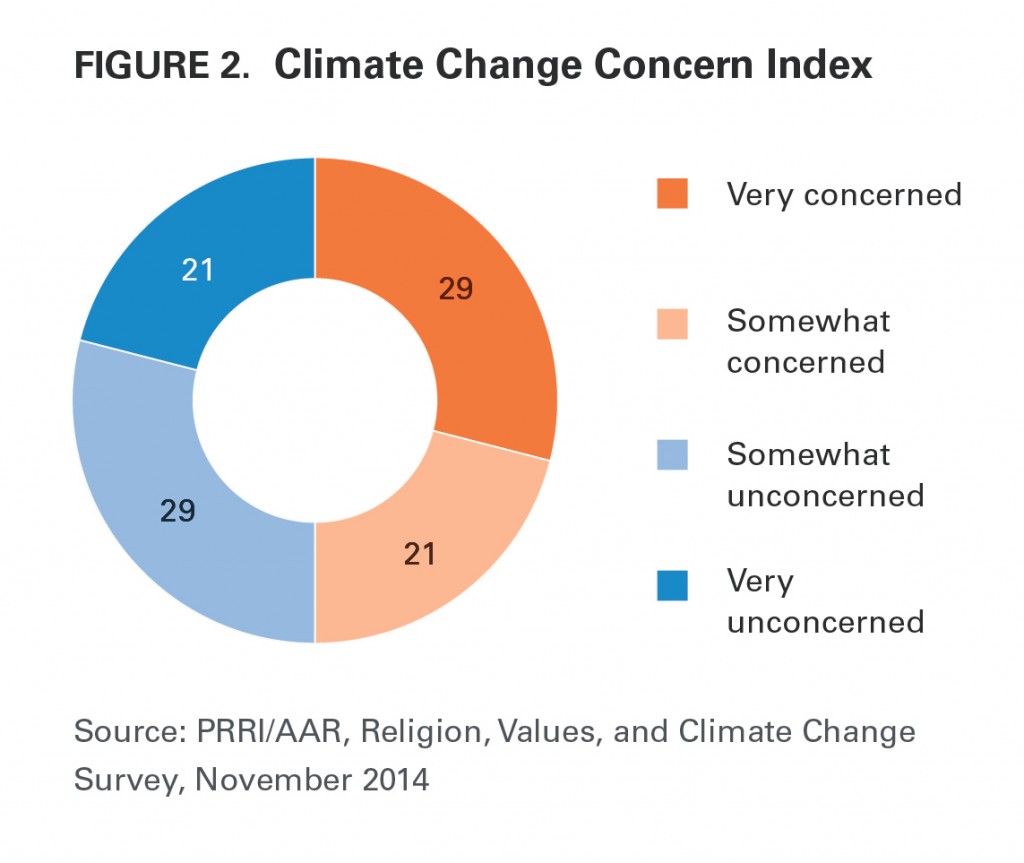 The Climate Change Concern Index reveals major differences by race, political affiliation, and religious affiliation. Nonwhite Americans are significantly more likely than white Americans to be highly concerned about climate change. More than 7-in-10 Hispanic Americans and nearly 6-in-10 black Americans are very (46% and 36%, respectively) or somewhat (25% and 21%, respectively) concerned about climate change, compared to less than half of white Americans (23% and 20% respectively).
The Climate Change Concern Index reveals major differences by race, political affiliation, and religious affiliation. Nonwhite Americans are significantly more likely than white Americans to be highly concerned about climate change. More than 7-in-10 Hispanic Americans and nearly 6-in-10 black Americans are very (46% and 36%, respectively) or somewhat (25% and 21%, respectively) concerned about climate change, compared to less than half of white Americans (23% and 20% respectively).
Similarly, two-thirds of Democrats are either very concerned (41%) or somewhat (26%) concerned about climate change, while fewer than 3-in-10 Republicans are very (14%) or somewhat (15%) concerned about climate change. Independents are divided: nearly half say they are very (28%) or somewhat (21%) concerned, while a similar number are somewhat (31%) or very (20%) unconcerned about climate change.
Religious Americans’ level of concern about climate change varies along racial and ethnic lines. Divides among Catholics provide a vivid example. Nearly three-quarters of Hispanic Catholics are very concerned (43%) or somewhat (30%) concerned about climate change, while approximately 4-in-10 white Catholics are very (17%) or somewhat (24%) concerned about climate change. Six-in-ten white Catholics are somewhat (32%) or very (28%) unconcerned about climate change.
Perceptions of Public Importance: “Climate Change” vs. “Global Warming”
The way climate change is described can have a modest effect on the perceived importance of the issue. Although the terms “global warming” and “climate change” are often used interchangeably, previous work has shown that the terms evoke different reactions.(3) In order to assess the degree to which Americans are influenced by different climate change terminology, the survey included a randomized experiment. Half of the respondents were asked whether “the issue of climate change is getting more attention than it deserves,” while the other half of the sample was asked whether “the issue of global warming is getting more attention than it deserves.”
Americans respond to the two descriptors slightly differently. A majority of Americans (54%) disagree that “the issue of climate change is getting more attention than it deserves,” while 43% agree. Fewer Americans (50%) disagree that “the issue of global warming is getting more attention than it deserves,” while significantly more (49%) agree.
These changes in terminology have an impact on different political groups’ perceptions of climate change. In general, respondents express more concern over “climate change” than “global warming.” Notably, the effects are in the same direction, even across ideological lines. While 38% of Democrats agree that the issue of global warming is receiving too much attention, only 24% say the same of climate change. Similarly, 75% of Tea Party members agree that global warming receives too much attention, while only 64% say the same of climate change. Republicans’ and independents’ views remain constant regardless of terminology.
Women are also more sensitive to changes in wording than men. A slim majority (51%) of women say that global warming is receiving too much attention, while only 40% say the same of climate change. Men’s views remain constant across the two descriptors.
III. Three Factions in the Climate Change Debate: Believers, Sympathizers and Skeptics
American attitudes have been stable over the last few years on the question of whether the global temperature is increasing. Nearly 7-in-10 (69%) Americans believe that there is solid evidence that the average temperature on earth has been increasing over the past few decades, while approximately one-quarter of Americans (26%) say they do not believe the earth is getting warmer. In 2011, an identical number of Americans (69%) said the average global temperature was rising.
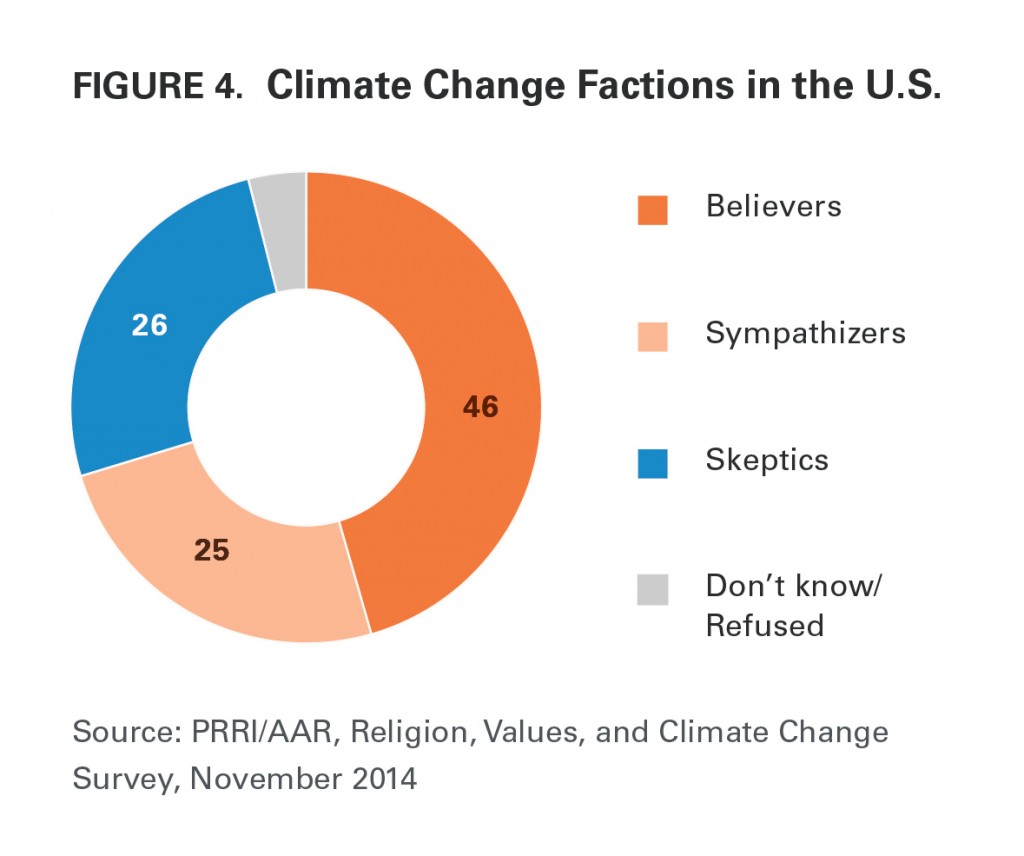 Although Americans generally believe the earth’s climate is getting warmer, there is less consensus about why this rise in temperature is occurring. Close to half (46%) of Americans say that the earth is getting warmer and that these changes are primarily the result of human activity, a group we characterize as climate change “Believers.” One-quarter (25%) of Americans believe the global temperature is rising but attribute this change to natural fluctuations in the earth’s environment or are uncertain about the cause. We identify this group as climate change “Sympathizers.” Finally, more than one-quarter (26%) of Americans say there is no evidence to support the idea that the temperature on earth has been rising over the past few decades, a group we label climate change “Skeptics.
Although Americans generally believe the earth’s climate is getting warmer, there is less consensus about why this rise in temperature is occurring. Close to half (46%) of Americans say that the earth is getting warmer and that these changes are primarily the result of human activity, a group we characterize as climate change “Believers.” One-quarter (25%) of Americans believe the global temperature is rising but attribute this change to natural fluctuations in the earth’s environment or are uncertain about the cause. We identify this group as climate change “Sympathizers.” Finally, more than one-quarter (26%) of Americans say there is no evidence to support the idea that the temperature on earth has been rising over the past few decades, a group we label climate change “Skeptics.
A Profile of Climate Change Believers, Sympathizers, and Skeptics
The three groups have substantially different political leanings. A majority (54%) of Skeptics are politically conservative, compared to 41% of Sympathizers and 23% of Believers. Conversely, climate change Believers (38%) are more likely than Sympathizers (18%) and Skeptics (10%) to identify as politically liberal.
The religious profile of each group is also distinct. Only 11% of Believers are white evangelical Protestants, compared to 22% of Sympathizers and 28% of Skeptics. Believers (28%) are more likely to be religiously unaffiliated than Sympathizers (18%) or Skeptics (17%). Only 30% of Believers attend religious services at least once a week, compared to 39% of Sympathizers and nearly half (47%) of Skeptics. Similarly, only 29% of Believers say the Bible is the literal word of God compared to 41% of Sympathizers and 41% of Skeptics.
However, the groups have largely similar educational backgrounds. Roughly equal numbers of climate change Believers (33%), Sympathizers (28%), and Skeptics (30%) have at least a college education although Sympathizers (47%) are somewhat more likely than Believers (40%) or Skeptics (40%) to report having a high school education or less.
There are also few differences between the three groups in terms of their overall interest in science. Roughly equal numbers of climate change Believers (13%), Sympathizers (12%), and Skeptics (10%) say that their favorite news topic is science and technology. However, Believers (30%) are more likely than Sympathizers (23%) or Skeptics (21%) to say they pay a lot of attention to developments in science.
Despite their belief in the existence of climate change, Believers are only slightly more likely than Sympathizers and Skeptics to say that climate change should be a higher priority than other social and economic problems like the lack of jobs, the budget deficit, or the gap between the rich and the poor. Only eight percent of Believers say climate change is the most important issue facing the U.S. today compared to three percent of Sympathizers and three percent of Skeptics. However, Believers (40%) are more likely than Sympathizers (17%) or Skeptics (11%) to identify climate change as the country’s most important environmental problem.
Climate change Believers are substantially more likely to than Sympathizers or Skeptics to score high on the Climate Change Concern scale. Nearly three-quarters of climate change Believers are very (47%) or somewhat (27%) concerned about climate change. About one-quarter of Believers are somewhat (23%) or very (3%) unconcerned. By contrast, about 4-in-10 Sympathizers are very (20%) or somewhat (22%) concerned about climate change, while a majority of Sympathizers are somewhat (37%) or very (21%) unconcerned. Fewer than 1-in-5 Skeptics are very (7%) or somewhat (11%) concerned about climate change, while more than 8-in-10 Skeptics say they are somewhat (31%) or very (51%) unconcerned.
Beliefs and Doubts about Climate Change
Climate change Believers, Sympathizers, and Skeptics constitute significantly different proportions of the major political parties in the U.S. Nearly two-thirds (65%) of Democrats are climate change Believers, 20% are Sympathizers, and 13% are Skeptics. By contrast, fewer than 1-in-4 Republicans (22%) are climate change Believers, 28% are Sympathizers, and nearly half (46%) are Skeptics. Americans who identify with the Tea Party are even more skeptical about climate change than Republicans. Less than one-quarter (23%) of Tea Party members are climate change Believers, 23% are Sympathizers, and a majority (53%) of Tea Party members are Skeptics. Independents closely mirror Americans as a whole.
The distribution of climate change Believers, Sympathizers, and Skeptics is also uneven across religious groups. Nearly two-thirds (66%) of Jewish Americans and close to 6-in-10 (57%) religiously unaffiliated Americans are climate change Believers, while white mainline Protestants and Catholics closely resemble the general public. Half (50%) of black Protestants are Believers, while 32% are Sympathizers and 16% are Skeptics. Only 27% of white evangelical Protestants are climate change Believers, while 29% are Sympathizers and nearly 4-in-10 (39%) are Skeptics.
There are only modest differences by age and level of educational attainment. Close to half (47%) of young adults (age 18 to 29) and roughly 4-in-10 (42%) seniors (age 65 and older) are climate change believers. In contrast, 30% of seniors and 22% of young adults are climate change Skeptics.
Reasons for Doubting Climate Change
In order to better understand why some Americans do not believe the earth has gotten warmer over the past few decades, climate change Skeptics were asked to share, in their own words, why they hold this view. Answers vary considerably, but respondents are most likely to point to personal weather experiences. One-third (33%) of climate change Skeptics report that they have not noticed a change in their own weather or that the weather is actually getting colder where they live. One response was typical of these views: “I live in Chicago and it’s cold as hell.” An other also mentioned the recent winter: “I hunt a lot, and last winter I froze my butt off.” Roughly 1-in-5 (18%) respondents attribute changing temperatures to natural variations in the environment. One respondent captured this view: “I think there are just trends where the temperature goes up and down as part of a natural cycle every couple of hundred years.”
Approximately 1-in-10 (12%) Skeptics explain that there is insufficient or conflicting scientific evidence. In one respondent’s words: “I don’t see any real evidence of that in the news media. The entire scientific community really appears divided and scattered about the entire issue.” Another Skeptic went so far as to say that global warming had not yet been proven: “There is a lot of conjecture. I don’t believe there is any evidence.” Substantially fewer respondents base their views on general personal observations about things they have heard or read (4%), say the new reports and data showing global warming were propaganda or somehow false (5%), or provide alternative theories to support their view (4%). One respondent, for example, doubts the earth was warming because “the ozone layer is being recovered,” while another explained that “there are no sun spots at the moment.”
Perceptions of Scientific Consensus, 2014 vs. 2011
Nearly half (48%) of Americans say that scientists generally agree that the earth is getting warmer because of human activity. Twenty-eight percent of the public say that scientists are divided over the issue, while fewer than 1-in-5 (17%) say that most scientists disagree that the earth is warming as the result of human activity. Today, Americans are more likely to agree that there is scientific consensus about the human impact on global warming than they were in 2011. In 2011, 4-in-10 (40%) Americans said that scientists generally agree about the existence and cause of climate change, compared to 37% who said the scientific community is divided, and 15% who said that scientists disagree that humans are responsible.
There are large partisan divides on this question. More than 6-in-10 (61%) Democrats believe scientists generally agree that humans are responsible for rising global temperatures, a view held by about one-third (34%) of Republicans and fewer than 3-in-10 (29%) Americans who identify with the Tea Party movement.
Climate change Believers, Sympathizers, and Skeptics also have very different views about the existence of a scientific consensus on climate change. Nearly two-thirds of believers (65%) say that scientists generally agree about the causes of climate change compared to 41% of sympathizers and 26% of skeptics.
IV. Perceived Impact of Climate Change
The Relationship between Climate Change and Other Environmental Problems
Americans attribute a number of major environmental problems to the existence of climate change. A majority (57%) of Americans believe that climate change is a major factor in causing water shortages and droughts. Majorities of Americans also say climate change is a major factor in causing more extreme storms (55%), food shortages and rising food prices (52%), and more intense wildfires (51%). Less than half of Americans say climate change is largely responsible for the erosion of coastlines and beaches (48%) or conflicts over scarce resources (40%).
Americans have different assessments of the environmental threats associated with climate change, depending on where they live. Americans who live in the Northeast are more likely than Americans living in the South to say climate change is a major factor in causing more extreme storms and hurricanes (60% vs. 52%) and more likely than Midwesterners and Southerners to say it is a major factor in the erosion of coastlines and beaches (62% vs. 40% and 45%, respectively). Americans who live in the Northeast (61%) and West (67%) are also more likely than those living in the South (53%) and Midwest (53%) to say climate change is a major factor in causing water shortages and droughts.
Among political groups, Democrats are most likely to identify climate change as the cause of a wide range of environmental problems, while Republicans and members of the Tea Party express greater doubt about these links. Independents mirror the general population. For instance, more than 7-in-10 (71%) Democrats and a slim majority (52%) of independents say that climate change is a major factor behind more extreme storms and hurricanes compared to fewer than 4-in-10 Republicans (34%) and members of the Tea Party (36%).
Recent Natural Disasters: Evidence of Climate Change or the Biblical “End Times”?
Overall, Americans are more likely to say that recent natural disasters are the result of climate change (62%) than they are to say these disasters are evidence that the U.S. is experiencing the “end times” as described in the Bible (49%). However, the number of Americans who believe that natural disasters are evidence of the apocalypse has increased somewhat over the past couple years. In 2011, approximately 6-in-10 (58%) Americans said that severity of recent natural disasters is proof of climate change, while 44% of Americans reported that the severity of recent natural disasters is a sign of the biblical “end times.”
Americans from different religious backgrounds vary in their willingness to attribute the severity of recent natural disasters to the biblical end times. White evangelical Protestants are substantially more likely to attribute the severity of recent natural disasters to biblical end times (77%) than climate change (49%). While nearly three-quarters (74%) of black Protestants also agree that natural disasters are a sign of the apocalypse, they are about as likely to see these natural disasters as evidence of climate change (73%). Substantially fewer Catholics (43%), white mainline Protestants (35%), and religiously unaffiliated Americans (29%) see recent natural disasters as evidence of the biblical end times.
Views about whether worsening natural disasters are evidence of climate change or a sign of the apocalypse varies by level of educational attainment. More than 6-in-10 Americans with a post-graduate education say the severity of recent natural disasters is a sign of climate change (62%), while fewer than one-quarter (22%) attribute these disasters to the biblical end times. Americans with a high school education or less, by contrast, are roughly as likely to say that these disasters are a result of climate change (67%) as they are to say that the explanation is biblical end times (61%).
V. Religion vs. Science: Perceptions of Conflict
Conflicts between Scientists and Religious People
When asked whether scientists and religious people are in conflict, Americans perceive the tensions to be largely one-sided. Americans are much more likely to say that religious people mistrust science and scientists than they are to say that scientists are disrespectful toward religion and religious people. Half (50%) of Americans say that scientists are generally respectful of religion and religious people, while 36% say they are mostly disrespectful. By contrast, only about one-third (34%) of Americans say that religious people are mostly trusting of science and scientists, while a majority (54%) say that religious people are mostly distrustful of science and scientists.
Americans with different religious backgrounds diverge in their perceptions of how scientists view religious people although there is more agreement that religious people are generally suspicious of science and scientists. Majorities of religiously unaffiliated Americans (62%), Catholics (55%), and white mainline Protestants (55%) say that scientists are mostly respectful of religion and religious people compared to approximately 4-in-10 white evangelical Protestants (40%) and black Protestants (39%). Roughly half of white evangelical Protestants (49%) and black Protestants (50%) say that scientists treat religion and religious people with disrespect.
By contrast, majorities of religiously unaffiliated Americans (64%), black Protestants (61%), and white evangelical Protestants (54%) say that religious people are mostly distrustful of science and scientists. White mainline Protestants and Catholics are about as likely to say that religious people trust science and scientists (40% and 41%, respectively) as they are to say that religious people do not trust science and scientists (44% and 46%, respectively).
Americans’ perceptions of the level of trust and respect between religious people and scientists also varies according to political affiliation. A majority of Democrats (54%) and independents (52%) say scientists generally are respectful of religion and religious people. Republicans are more divided: 43% say scientists generally have respectful attitudes toward religion, but nearly half (46%) say scientists are disrespectful of religion and religious people. Only 35% of Americans who identify with the Tea Party believe scientists treat religious people with respect, while a slim majority (51%) disagree.
Democrats and independents also differ from Republicans and Tea Party members about religious peoples’ attitudes toward scientists and science. Nearly 6-in-10 Democrats (59%) and independents (57%) say that religious people are distrustful of science. Republicans and members of the Tea Party, on the other hand, are closely divided. Nearly half of Republicans (46%) and Tea Party members (47%) say that religious people generally distrust science and scientists, while more than 4-in-10 disagree, saying that religious people tend to trust science (42% and 43%, respectively).
Conflicts Between Science and Religion
A majority of Americans (54%) believe that science and religion are often in conflict, while 40% say they are mostly compatible. Perceptions about this issue have not changed significantly over the past five years. In 2009, a similar number (55%) of Americans agreed that science and religion are often in conflict, while fewer than 4-in-10 (38%) said that science and religion are mostly compatible. With only a few exceptions, Americans across political and religious divides affirm this sentiment.
Majorities of every religious group—with the exception of white mainline Protestants—believe that science and religion are often in conflict, including religiously unaffiliated Americans (65%), black Protestants (62%), Jewish Americans (58%), white evangelical Protestants (55%), and Catholics (51%). A slim majority (51%) of white mainline Protestants say that science and religion are mostly compatible, while 42% of white mainline Protestants say that religion and science are often in conflict.
There is little disagreement according to political affiliation about whether science and religion are often at odds. Majorities of Democrats (56%), independents (56%), members of the Tea Party (56%), and Republicans (51%) agree that science and religion are often in conflict.
Conflicts Between Science and Personal Religious Beliefs
Although many Americans believe that science and religion are generally at odds, substantially fewer people believe that science clashes with their own religious beliefs. Nearly 6-in-10 (59%) Americans say that science does not conflict with their own religious beliefs, while roughly 4-in- 10 (38%) disagree, saying that science sometimes conflicts with their religious beliefs. Perspectives on this issue have been stable over the last few years. In 2009, more than 6-in-10 (61%) Americans said that their religious beliefs were not at odds with science.
Majorities of most religious groups say their beliefs do not conflict with science with two exceptions. Majorities of Jewish Americans (77%), religiously unaffiliated Americans (73%), white mainline Protestants (63%), and Catholics (55%) report that their religious beliefs are not in conflict with science. By contrast, a majority (52%) of white evangelical Protestants say their religious beliefs do conflict with science, while 46% say they do not. Black Protestants are divided: 50% say their religious beliefs conflict with science, while nearly as many (47%) disagree.
Americans who identify with the Tea Party are alone among political groups in saying that their religious beliefs are at odds with science. A majority of Democrats (62%), independents (60%), and Republicans (54%) do not believe that their personal religious beliefs conflict with science. However, a majority (52%) of Tea Party members say their religious beliefs conflict with science, while 46% disagree.
VI. Spirituality, Values, and the Environment
Values and Protecting the Environment
Americans generally agree that a range of values undergird their desire to protect the environment, including living up to the responsibility to protect future generations, respecting and taking care of the earth, preventing human suffering and harm, and living up to our responsibility to protect other species.
Nearly 9-in-10 Americans say that living up to our responsibility to protect future generations is an extremely (51%) or very (38%) important reason for protecting the environment. About 1-in-10 (9%) say it is a somewhat important reason, and just two percent say it is not too important (1%) or not an important reason at all (1%).
Similarly, nearly 9-in-10 Americans say that respecting and taking care of the earth is an extremely (48%) or very (40%) important reason for protecting the environment. One-in-ten (10%) say it is a somewhat important reason, and two percent say it is not too important (1%) or not an important reason at all (1%).
More than 8-in-10 Americans say preventing human suffering and harm is an extremely (47%) or very (38%) important reason for protecting the environment, while 1-in-10 (10%) Americans say it is a somewhat important reason. Four percent of Americans say that preventing human suffering and harm is not too important (2%) or not an important reason at all (2%).
Americans’ support for the value of protecting other species is less intense. Three-quarters of Americans say that living up to our responsibility to protect other species is an extremely (37%) or very (38%) important reason for protecting the environment. One-in-five (20%) Americans say it is a somewhat important reason to protect the environment, while five percent say it is not too important (3%) or not an important reason at all (2%).
More than 8-in-10 members of all major religious groups agree that living up to our responsibility to protect future generations, respecting and taking care of the earth and preventing human suffering and harm are extremely or very important reasons to protect the environment. There is less consensus about whether our responsibility to protect other species justifies environmental protection. White evangelical Protestants are more divided on this question than other religious Americans. Approximately two-thirds of white evangelical Protestants say that living up to our responsibility to protect other species is an extremely (31%) or very (36%) important reason to protect the environment, while about one quarter of white evangelical Protestants (26%) say it is somewhat important and fewer than 1-in-10 say is it not too important (5%) or not at all important (2%).
The value of living up to our responsibility to protect other species also divides Americans along partisan lines. More than 8-in-10 Democrats say living up to our responsibility to protect other species is an extremely (44%) or very (39%) important reason to protect the environment. Three-quarters of independents also say our responsibility to other species is an extremely (37%) or very (38%) important environmental value. Conversely, more than 6-in-10 Republicans and Americans who identify with the Tea Party say our obligation to other species is an extremely (26% and 34%, respectively) or very (39% and 34%, respectively) important environmental value.
Americans who report that any of these values are extremely important are more likely to be climate change Believers.
Spirituality and Concern about the Environment: The Spiritual Experiences Index
In order to explore the relationship between spirituality and perspectives on the environment, the survey include four measures to assess the frequency of personal spiritual experiences. Seven-in ten Americans say they “experience a connection to all life” every day (44%) or most days (26%). A similar number of Americans say they “feel deep inner peace or harmony” every day (30%) or most days (39%). More than 6-in-10 Americans say they “feel a deep connection with nature and the earth” every day (38%) or most days (26%). More than half of Americans say they “feel a deep sense of wonder about the universe” every day (30%) or most days (23%).
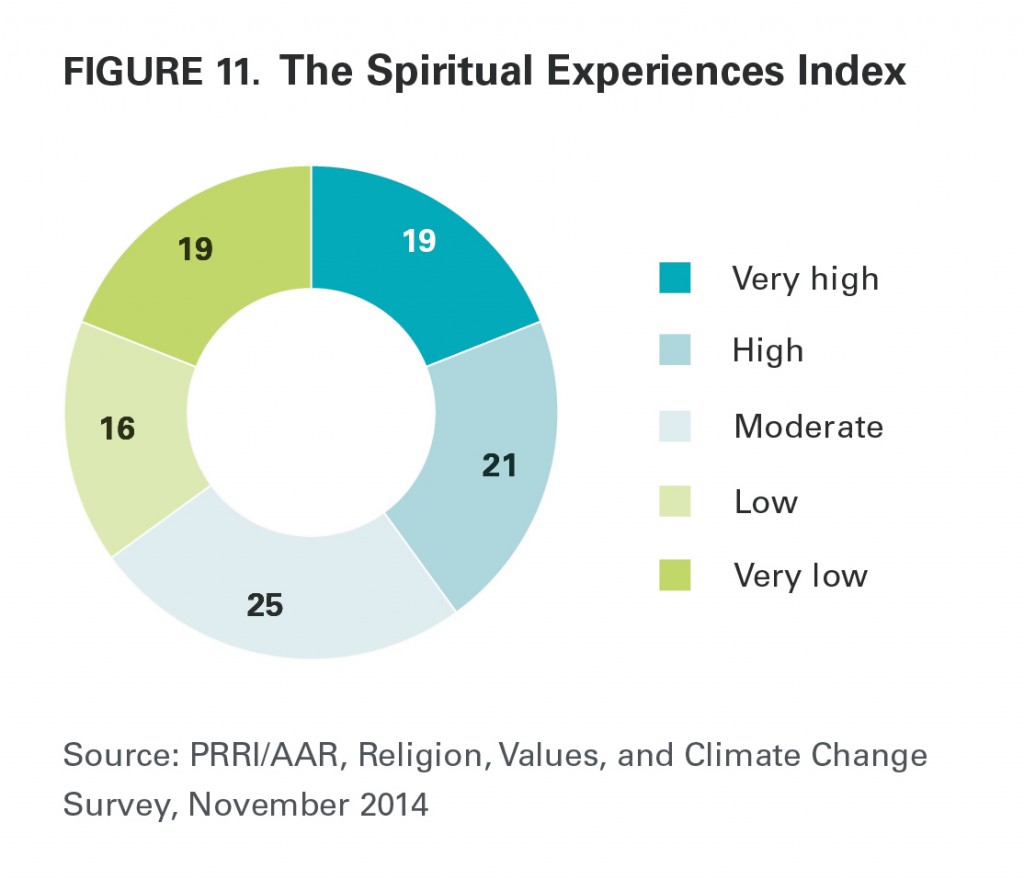 These four measures were combined using an additive scale into a Spiritual Experiences Index.(4) The Spiritual Experiences Index finds that 4-in-10 Americans report either very high (19%) or high (21%) frequency of spiritual experiences. One-quarter (25%) of Americans report moderate frequency of spiritual experiences. Approximately one-third of Americans report low (16%) or very low (19%) levels of spiritual experiences.
These four measures were combined using an additive scale into a Spiritual Experiences Index.(4) The Spiritual Experiences Index finds that 4-in-10 Americans report either very high (19%) or high (21%) frequency of spiritual experiences. One-quarter (25%) of Americans report moderate frequency of spiritual experiences. Approximately one-third of Americans report low (16%) or very low (19%) levels of spiritual experiences.
In general, Protestants report more frequent spiritual experiences than Catholics, Jewish Americans, and religiously unaffiliated Americans.(5) According to the Spiritual Experiences Index, nearly half of white evangelical Protestants (47%) and white mainline Protestants (45%) report high or very high frequency of spiritual experiences. About 4-in-10 (41%) black Protestants also report high or very high frequency of spiritual experiences. Substantially fewer Catholics (31%), Jewish Americans (29%), and religiously unaffiliated Americans (35%) report high or very high frequency of spiritual experiences.
The most notable demographic differences on the Spiritual Experiences Index are by age and gender. Seniors (age 65 and older) are significantly more likely than young adults (age 18-29) to report very high or high frequency of spiritual experiences (49% and 29%, respectively). Women (44%) are also likely than men (36%) to report very high or high frequency of spirituality. There are no significant differences on the Spiritual Experiences Index by party affiliation, race, region, or educational attainment.
There is no significant relationship between scores on the Spiritual Experiences Index and views about climate change. Nearly half (49%) of Americans who report very high frequency of spiritual experiences are climate change Believers. A similar number (44%) of Americans who report very low frequency of spiritual experiences are also climate change Believers.
Americans who report having spiritual experiences more often generally score higher on the Climate Change Concern Index. A majority of Americans who report very frequent spiritual experiences are very (35%) or somewhat (20%) concerned about climate change. In contrast, less than half of Americans who report very infrequent spiritual experiences are very (21%) or somewhat (20%) concerned about climate change.
VII. The Influence of Religious Institutions and Theology
Discussions of Climate Change within Congregations
Most Americans who attend religious services at least once or twice a month report hearing little from their clergy leader about the issue of climate change. Just over one-third say their clergy leader speaks about the issue of climate change often (11%) or sometimes (25%). More than 6-in-10 Americans who attend religious services at least once or twice a month say their clergy leader rarely (29%) or never (33%) speaks about the issue of climate change.
Non-white Americans who attend services at least once a month report significantly higher levels of clergy engagement with climate change. Seven-in-ten Hispanic Catholics say their clergy leader discusses climate change often (22%) or sometimes (48%). A slim majority of black Protestants also say their clergy leader speaks on the subject often (19%) or sometimes (32%). By contrast, only 3-in-10 white evangelical Protestants hear about climate change often (5%) or sometimes (25%) from clergy leaders. Similar numbers of white mainline Protestants report hearing their clergy leader discuss the issue often (10%) or sometimes (20%). Only 1-in-5 white Catholics say they hear about climate change often (5%) or sometimes (15%) from their clergy leader.
Nearly half (49%) of Americans who attend congregations in which religious leaders speak at least occasionally about climate change are climate change Believers. In contrast, only 36% of Americans who attend congregations where climate change is not often addressed are climate change Believers.
Americans who say their clergy leader speaks at least occasionally about climate change also score higher on the Climate Change Concern Index. More than 6-in-10 Americans who report hearing about climate change at least occasionally in church are very (38%) or somewhat (24%) concerned about climate change compared to fewer than 4-in-10 of those attending congregations where the issue is rarely (19%) or never (20%) raised.
Few Americans who attend religious services at least once or twice a month say their place of worship has ever sponsored events or education programs about the issue of climate change. Only about one-quarter (23%) of Americans who attend services at least once a month say their congregation or place of worship has sponsored events, educational programs, or group discussions about climate change, while nearly 7-in-10 (69%) say their congregation or place of worship has not sponsored any of these activities. Hispanic Catholics (44%) are more likely than any other group to say their congregation has sponsored climate change related activities. There are only minor differences among other religious affiliation groups. Black Protestants (27%) are slightly more likely to report that their church has sponsored an activity about climate change compared to 20% of white mainline Protestants, 15% of white evangelical Protestants, and 15% of white Catholics.
Americans who belong to a congregation or place of worship that sponsors activities about climate change are more likely to be climate change Believers than those who do not. Nearly half (48%) of Americans who belong to a congregation or place of worship that has sponsored an event, educational program, or group discussion on climate change are climate change Believers compared to 38% of Americans whose congregation has not sponsored such events.
Members of religious communities whose congregations sponsor programs or discussion sessions on climate change also score higher on the Climate Change Concern Index than those who do not attend such congregations. Nearly 6-in-10 (57%) Americans who are part of congregations that sponsor climate change activities report being at least somewhat concerned about climate change compared to 44% of those who attend congregations that do not offer such programming.
Theological Beliefs about Providence, Stewardship, and Creation
Most Americans do not believe that God would intercede to prevent humans from destroying the earth. Approximately 4-in-10 (39%) Americans believe that God would not allow humans to destroy the earth, while a majority (53%) of Americans disagree.
Beliefs about God’s willingness to allow humans to destroy the earth vary by race and religious affiliation. Hispanic Catholics and Black Protestants are likeliest to believe that God would not allow humans to destroy the planet. More than 6-in-10 (61%) Hispanic Catholics believe that God would not allow humans to destroy the earth, while 38% disagree. Similarly, a majority (59%) of black Protestants agree that God would not allow humans to destroy the earth, while about one-third (36%) disagree. White evangelical Protestants are more divided: 45% say that God would not allow humans to destroy the earth, while 48% disagree.
White Catholics, white mainline Protestants, Jewish Americans, and religiously unaffiliated Americans are substantially less likely to believe that God would intercede on the earth’s behalf. Nearly 4-in-10 (38%) white Catholics agree that God would not allow humans to destroy the earth, while a majority (56%) disagree. About one-third (35%) of white mainline Protestants agree that God would not allow humans to destroy the earth, while a majority (53%) disagree. Jewish and religiously unaffiliated Americans are least likely to believe that God would intervene to save the earth: approximately 1-in-5 Jewish (22%) and religiously unaffiliated (23%) Americans agree that God would not allow humans to destroy the earth, while about two-thirds of both groups (66% and 64%, respectively) disagree.
Americans generally reject the idea that God intended humans to use the earth strictly for human benefit. Nearly 6-in-10 (57%) Americans say God gave human beings the task of living responsibly with the animals, plants, and the resources of the planet, which are not just for human benefit, while about one-third (35%) of Americans believe God gave human beings the right to use animals, plants, and all the resources of the planet for human benefit.
Americans are divided along religious lines about whether God intended for humans to use animals, plants, and the planet’s resources for their own benefit. Strong majorities of Jewish Americans (68%), white mainline Protestants (66%), Hispanic Catholics (66%), white Catholics (58%), and religiously unaffiliated Americans (57%) say God gave human beings the task of living responsibly with the animals, plants, and the resources of the planet, which are not just for human benefit. By contrast, black Protestants and white evangelical Protestants are divided on this question. Half (50%) of black Protestants and white evangelical Protestants (49%) say God gave humans the task of living responsibly with a creation that is not just for human benefit, while 43% of black Protestants and 46% of white evangelical Protestants say God gave humans the right to use these resources for human benefit.
VIII. Potential Paths to Climate Change Solutions
Major Behavioral Sacrifices vs. Technology
Americans who believe that the earth’s temperature is rising are generally pessimistic about the extent to which technology can resolve the problems related to climate change without substantial sacrifices.(6)
More than 6-in-10 (64%) Americans who agree that the global temperature is increasing say that major sacrifices will have to be made in order to solve the climate change problem, while roughly 3-in-10 (28%) say that technology will be able to solve the problem of climate change without requiring substantial sacrifices.
Nearly three-quarters (74%) of Democrats and 6-in-10 (60%) independents who believe the earth is getting warmer say we will have to make major sacrifices to solve the problem of climate change. Fewer than half (49%) of Republicans who believe that global temperature rise is occurring agree, while 36% say that technology can solve the climate change problem without substantial sacrifices.
Among Americans who believe the earth is getting warmer, there are slight variances among different demographics. Young adults (age 18 to 29) who believe the earth is getting warmer are only somewhat more likely than seniors (age 65 and older) who hold a similar view to have confidence in technology’s ability to solve the problem without major sacrifices. Nearly one-third (31%) of young adults say that technology can solve the problem of climate change without substantial sacrifices compared to 21% of seniors. At least 6-in-10 young adults (60%) and seniors (67%) agree that major sacrifices will be required to solve the problem of climate change.
Men who say global temperatures are rising are also somewhat more optimistic than women who hold the same view about the extent to which technology can be harnessed to solve the issue of climate change. More than one-third (34%) of men who believe that climate change is occurring say technology can address the problem without substantial sacrifices, while only 23% of women agree.
Dealing with Climate Change: Now vs. the Future
Although Americans overall rank climate change low among a range of other potentially important issues, most prefer to address the issue now rather than postponing action. More than 6-in-10 (63%) Americans—regardless of whether they agree that the earth’s temperatures are rising—say that dealing with climate change now will help avoid more serious economic problems in the future, while 3-in-10 (30%) say that, given our current economic problems, we cannot afford to deal with climate change right now.
Notably, the generational differences on this question are modest. Nearly 7-in-10 (68%) young adults and nearly 6-in-10 (59%) seniors say we should deal with climate change now.
There are substantial political divides over whether action to deal with climate change should happen now or later. Nearly 8-in-10 (79%) Democrats and 64% of independents say we should deal with climate change now to avoid more serious economic problems in the future. Republicans, by contrast, are divided. Nearly half (47%) say that, given our current economic problems, we cannot afford to deal with climate change right now, while 43% say we should deal with climate change now to prevent future problems. A majority (52%) of Americans who identify with the Tea Party movement say that we cannot afford to deal with climate change right now, while 36% say we should address climate change right now.
Majorities of all religious groups—including 82% of Jewish Americans, 76% of black Protestants, 73% of religiously unaffiliated Americans, 69% of Hispanic Catholics, 63% of white Catholics, 56% of white mainline Protestants, and 52% of white evangelical Protestants—agree that dealing with climate change now will help prevent economic problems in the future.
Free Market vs. Government Policies
Americans overall are divided over whether they think the solution to rising temperatures will primarily come from private business and the free market (41%) or from government policies (42%). More than 1-in-10 Americans say the solution will come from both places (7%) or from neither place (5%).
Political groups disagree about the source of the solution for climate change. A majority of Democrats (52%) believe that climate change will be resolved mostly through government policies, while roughly one-third (34%) look to the free market. In contrast, Republicans and members of the Tea Party are much more likely to believe in the free market (50% and 56%, respectively) than government policies (32% and 24%, respectively) as the solution to climate change. Independents closely mirror the general public.
The Role of Government
Regardless of whether Americans believe the primary solution to climate change will come from the private or public sector, most support stronger government action on the issue. Nearly 7-in-10 (69%) Americans believe that the U.S. government needs to do more to address the issue of climate change, while 29% disagree. Support for increased government involvement has remained stable over the past two years. In 2012, two-thirds (67%) of Americans supported increased government involvement to address climate change.
There are stark partisan divisions when it comes to views about government action on climate change. Nearly 9-in-10 (88%) Democrats and 7-in-10 (69%) independents agree that the U.S. government should become more involved in addressing climate change, while less than half (44%) of Republicans and Tea Party members (39%) agree. A majority (54%) of Republicans and nearly 6-in-10 (58%) Tea Party members disagree that government needs to do more to address climate change.
IX. Support for Specific U.S. Energy Policies
Limits on Power Plant and Vehicle Emissions
Americans are broadly supportive of energy policies that place additional limits on carbon dioxides emissions, even if such policies impose new costs. Nearly two-thirds (64%) of Americans support placing stricter limits on vehicle emissions even if it results in higher car prices for consumers, while roughly one-third (32%) of Americans are opposed. Three quarters (75%) of Democrats, 64% of independents, and a slim majority (51%) of Republicans favor these limits, although a sizeable minority (44%) of Republicans oppose them. Less than half (45%) of Tea Party members favor these limits, while 54% are opposed.
Nearly 6-in-10 (57%) Americans favor placing stricter limits on the amount of carbon dioxide emitted from power plants even if it raises prices of goods and services, while 38% are opposed. Seven-in-ten (70%) Democrats and a majority (55%) of independents favor stricter limits on power plants, while Republicans (47% favor, 48% oppose) and Tea Party members (51% favor, 48% oppose) are divided.
Energy Production: The Keystone XL Pipeline and Fracking
Americans are more divided over policies that would promote increased production from traditional fossil fuels. A majority (52%) of Americans support the building of the Keystone XL pipeline, which would transport oil from Canada’s oil sands region through the Midwest to refineries in Texas, while nearly 4-in-10 (37%) are opposed to the pipeline and approximately 1-in-10 (11%) have no opinion. More than three-quarters (77%) of Tea Party members, 71% of Republicans, and a slim majority (51%) of independents favor building the Keystone XL Pipeline. By contrast, only 42% of Democrats favor building the pipeline, while 49% are opposed.
Conversely, a slim majority (51%) of Americans oppose the increased use of “fracking,” a drilling method that uses high-pressure water and chemicals to extract oil and natural gas form underground rock formations, while more than 4-in-10 (41%) Americans agree that the use of fracking in the U.S. should be expanded. Majorities of Democrats (59%) and independents (55%) oppose increased use of fracking. By contrast, only 36% of Republicans and 28% of Tea Party members oppose the increased use of fracking, while a majority (56%) of Republicans and 64% of Tea Party members support it.
Carbon Tax
Americans are nearly evenly divided in their support for a policy that would impose an additional tax on companies that produce fossil fuels like coal, oil, and natural gas, even if the policy results in higher electricity costs. Forty-seven percent of Americans favor such a tax, while 48% are opposed.
There are substantial divisions on this question by educational attainment. Nearly two-thirds (64%) of Americans with a post-graduate education and a majority (54%) of Americans with a four-year college education favor a tax on fossil fuel producers compared to less than half (43%) of Americans with a high school education or less.
The views of Democrats and independents also diverge from those of Republicans and Tea Party members. A majority of Democrats (56%) and a slim majority of independents (51%) favor an additional tax on companies that produce fossil fuels. By contrast, less than one-third of Republicans (32%) and members of the Tea Party (31%) favor a carbon tax, while 65% of Republicans and 68% of Tea Party members are opposed.
Increased Funding for Renewable Energy
Nearly two-thirds (64%) of Americans favor increasing federal funding for research on renewable energy sources such as wind, solar and hydrogen even if it raises taxes. One-third (33%) of Americans oppose such an increase.
Americans are primarily divided along political lines on the question of federal funding for renewable energy. More than three-quarters (76%) of Democrats and close to two-thirds (65%) of independents favor increased federal investment in renewable energy even if it raises taxes. Republicans are closely divided. A slim majority (51%) of Republicans oppose greater investment in federal funding for renewable energy, while 48% support increasing federal funding. Less than one-third (32%) of Tea Party members favor spending more federal money on renewable energy, while two-thirds (67%) are opposed.
Endnotes
1 General Social Survey, 2006.
2 The Cronbach’s alpha for the two items is 0.691, indicating that they scale together reasonably well. The 7-point linear scale identifies four distinct groupings: highly concerned (2,3), somewhat concerned (4), not too concerned (5,6), and not at all concerned (7,8). Lower scores on the scale indicate higher concern. The scale does not include respondents who answered “don’t know” or refused.
3 Schuldt, Jonathon P., Sara H. Konrath, and Norbert Schwarz. 2011. “‘Global Warming’ or ‘Climate Change’? Whether the Planet is Warming Depends on Question Wording.” Public Opinion Quarterly 75(1): 115–24.
4 The Cronbach’s alpha for the four items used in the scale is 0.719, which indicates that they are suitable for the inclusion in a single scale. The Spiritual Experiences Index was created as an additive scale from the four questions above and produced a score range of 4-20. Categories were created as follows: very high (score of 19-20), high (score of 17-18), moderate (score of 15-16), low (score of 13-14), very low (score of 4-12). The scale does not include respondents who answered “don’t know” or refused.
5 Notably, this pattern also holds true for the spirituality measure most directly related to the environment. Protestants generally report feeling a connection to nature and the earth more often than members of other religious groups. At least 4-in-10 white evangelical Protestants (40%), white mainline Protestants (45%), and black Protestants (40%) say they feel a “deep connection to nature and the earth” at least every day. By contrast, roughly one-third of religiously unaffiliated Americans (34%), Catholics (31%), and Jewish Americans (31%) report feeling a deep connection to nature daily.
6 Because the stem of this question assumes that the earth is getting warmer, analysis on this question is screened on the subset of Americans who believe the earth is getting warmer.
7 Telephone usage refers to whether respondents have only a landline telephone, only a cell phone or both types.
Recommended citation:
Jones, Robert P., Daniel Cox, and Juhem Navarro-Rivera. “Believers, Sympathizers, & Skeptics: Why Americans Are Conflicted about Climate Change, Environmental Policy, and Science.” PRRI. 2014. http://www.prri.org/research/believers-sympathizers-skeptics-americans-conflicted-climate-change-environmental-policy-science/.
